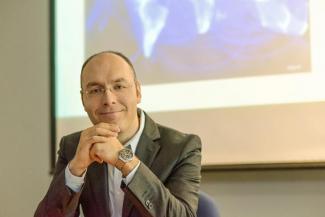
SMU Assistant Professor Michael Genkin studies the intricate social networks that exist between people.

Photo Credit: Cyril Ng
By Yamini Chinnuswamy
SMU Office of Research – It takes two human beings to create another human being. Known as a dyad, the smallest possible social unit, it is the first social network we are acquainted with. As we grow up, the networks we develop from school, work and hobbies may guide us through the various stages of life.
Assistant Professor Michael Genkin from the Singapore Management University (SMU) School of Social Sciences is attracted to the idea that human societies can be best understood through social networks such as these. “If you think of society as a giant tapestry, you want to understand how the tapestry’s threads are woven together and form the various relationships that make up the social fabric. I’m always struck by the fact that relationships are everywhere, both visible and invisible.”
From book clubs to street gangs
Professor Genkin explores social networks through a framework he first proposed in graduate school called Blau Status Analysis. This analytical framework allows for the study of micro-level processes such as the profile of individuals recruited by organisations, how these organisations compete for recruits, and the impact of membership on these individuals. The organisations he studies have voluntary membership, and can include anything from church groups to book clubs—or even street gangs.
In an ongoing study, Professor Genkin uses Blau Status Analysis to better understand the type of people who belong to deviant organisations such as criminal or terrorist groups. “Blau Status Analysis allows us to identify, with a high degree of accuracy, the type of individuals who belong to these organisations, based on their patterns of recruitment,” he explains. “When these organisations compete with one another, they draw members from a particular niche. The method allows us to identify members of the organisation purely based on the niche, thus providing a new diagnostic tool.”
In the particular dataset that Professor Genkin studied, his method was able to robustly predict such memberships, and was even more accurate than traditional prediction methods such as profiling based on known member characteristics. He is presenting some of this work at the upcoming American Sociological Association meeting at Chicago. His other papers that use Blau Status Analysis are currently under review.
All for one, and one for all
A distinct, but parallel research stream of Professor Genkin’s is in the area of political violence and terrorism, where he investigates how the terrorist tactic of suicide bombing has diffused around the world. With experts estimating that the rate of suicide bombings has been sharply increasing in recent years, the complex psychology and sociology underlying it has become of great relevance to the international community.
“But why do some groups adopt the suicide bombing tactic while others do not?” he asks. “The Basques in Spain, for example, do not, while the Tamil Tigers in Sri Lanka have had a long tradition of doing so.”
Professor Genkin and his collaborators proposed that the answer is found in the level of collectivism versus individualism of a group’s cultural milieu: terrorist organisations embedded in individualist cultures are less likely to use suicide bombing tactics than those embedded in collectivist cultures.
“I like to explain it with the Three Musketeers slogan—all for one, and one for all. In collectivist cultures, it’s one for all. In individualist cultures, it’s all for one,” he says. “As such, collectivist cultures are more accepting of suicide bombing tactics because in times of conflict, they view it as more acceptable or honourable to sacrifice a person for the good of the larger group. By contrast, it draws out revulsion in individualist cultures, where the preciousness of each life is paramount.”
Measures of a country’s collectivism can accurately predict whether its terrorist groups might or might not adopt suicide bombings, net of other factors such as Islamist ideology, says Professor Genkin. “When we submitted our initial findings for publication, one of our reviewers asked us to extend our timeline, which originally ended in 2010, to include data from 2014.”
In the process of collecting more data, they looked at countries and regions which are collectivist, have Islamist components, and are geographically proximate to areas where the tactic was used previously. Based on his diffusion model, Sub-Saharan Africa was the only place on the map that Professor Genkin classified as “at risk” but which did not witness any suicide bombings up to 2010.
Fast forward to 2015, he notes, the number of suicide bombing cases has surged in the region, from the east coast of Sub-Saharan Africa—such as Somalia, where the militant group al-Shahab operates, to the west coast—such as the northern part of Nigeria, which has been extensively terrorised by Boko Haram fighters in the past few years. “It suggests that the model is predictive and that our results are robust,” he remarks.
Social networks in the Singapore context
From predictive studies of street gangs to suicide bombers, Professor Genkin has shown the relevance of his models to social problems and international security threats. “I aim to create powerful, predictive and explanatory models that shed light on important questions,” he says.
A recent addition to the SMU faculty, Professor Genkin is continuing his work on social networks from a Singapore context. “People have collected specific sub-sectional network data from high schools or firms, but a nationally representative effort of network data hasn’t yet been undertaken in Singapore, as far as I can tell. That’s something I would like to contribute to, particularly because there is a lot of room to develop sociological theory from the Singaporean perspective,” he says.
Back to Research@SMU Issue 26